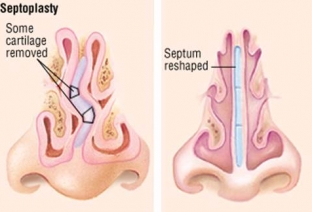Difficult nasal breathing, chronic rhinitis and snoring. All this can be a consequence of the curvature of the nasal septum. This slight deviation can lead to serious health problems. Therefore, today the editors of Estet-portal will tell you about the causes of this problem and how to solve it.
Deviated septum – this is a shift of the plate that divides the nasal cavity into two parts, to one or both sides. This shift provokes a number of problems associated with nasal breathing.
Causes of deviated septum
There are several types of deviated septum, which are divided by reason of occurrence. So, among the causes of the curvature of the nasal septum, we can distinguish:
- Injury to the nose, due to dislocation or fracture. This cause refers to the traumatic type of septal curvature.
- Heredity. As scientists have proven, a deviated nasal septum can be inherited. This reason refers to the physiological type of curvature.
- Incorrect development of the facial skeleton. This reason also applies to the physiological type of curvature.
- Exposure to irritants. May be the result of exposure to a previous disease, polyp or foreign body. Belong to the compensatory type of curvature.
It should be noted that a slight deviated septum is present in almost all people, but is not always a pathology.

Symptoms of deviated septum
Most of the symptoms are common to all types of curvature. Symptoms of a deviated septum include:
- difficult nasal breathing, up to its complete absence;
- nosebleeds;
- dry nose;
- decreased or absent sense of smell;
- chronic rhinitis;
- sinusitis;
- sinusitis;
- headaches;
- pain in the ear area;
- snoring;
- Change in the shape of the nose with a traumatic type of curvature.
If the degree of curvature is small, it may occur without any symptoms. In this case, it is not considered a pathology and does not require treatment.
Treatment of deviated septum
There are several ways to treat a deviated septum, depending on how severe it is. So, with a slight severity of the curvature of the septum, classical methods of treatment are used:
- rinsing the nose with special solutions;
- use of vasoconstrictor drugs, nasal drops and oral tablets;
- laser therapy;
- breathing exercises.
Of course, in case of serious violations of the anatomical structure of the nose and a large degree of curvature of the nasal septum, this treatment will have only a temporary and short-term effect. In such cases, they resort to a surgical method of treatment.
Nasal septum surgery
To correct a deviated septum, an operation called a septoplasty is performed. Unlike rhinoplasty, septoplasty is not aimed at restoring the shape of the nose, but at resuming its respiratory functions. Indications for septoplasty are:
- difficult or absent nasal breathing;
- persistent nosebleeds;
- chronic rhinitis;
- frequent sinusitis;
- heavy snoring.
During the operation, the surgeon removes the curved sections of the septum through the nostrils. In this case, the main part of the partition remains in place. Sometimes the surgeon may not remove, but put in place some parts of the deviated septum. The operation is performed in a hospital under general or local anesthesia.
Contraindications for septoplasty are:
- severe form of diabetes mellitus;
- blood clotting disorders;
- oncological diseases;
- infectious diseases;
- severe pathologies of internal organs.
In addition, septoplasty is not performed during an exacerbation of chronic diseases.
Remember to seek medical attention if you experience the symptoms described. After all, even a slight curvature that has these symptoms requires treatment. The editors of Estet-portal wish you to be healthy.
Source estet-portal.com






Add a comment